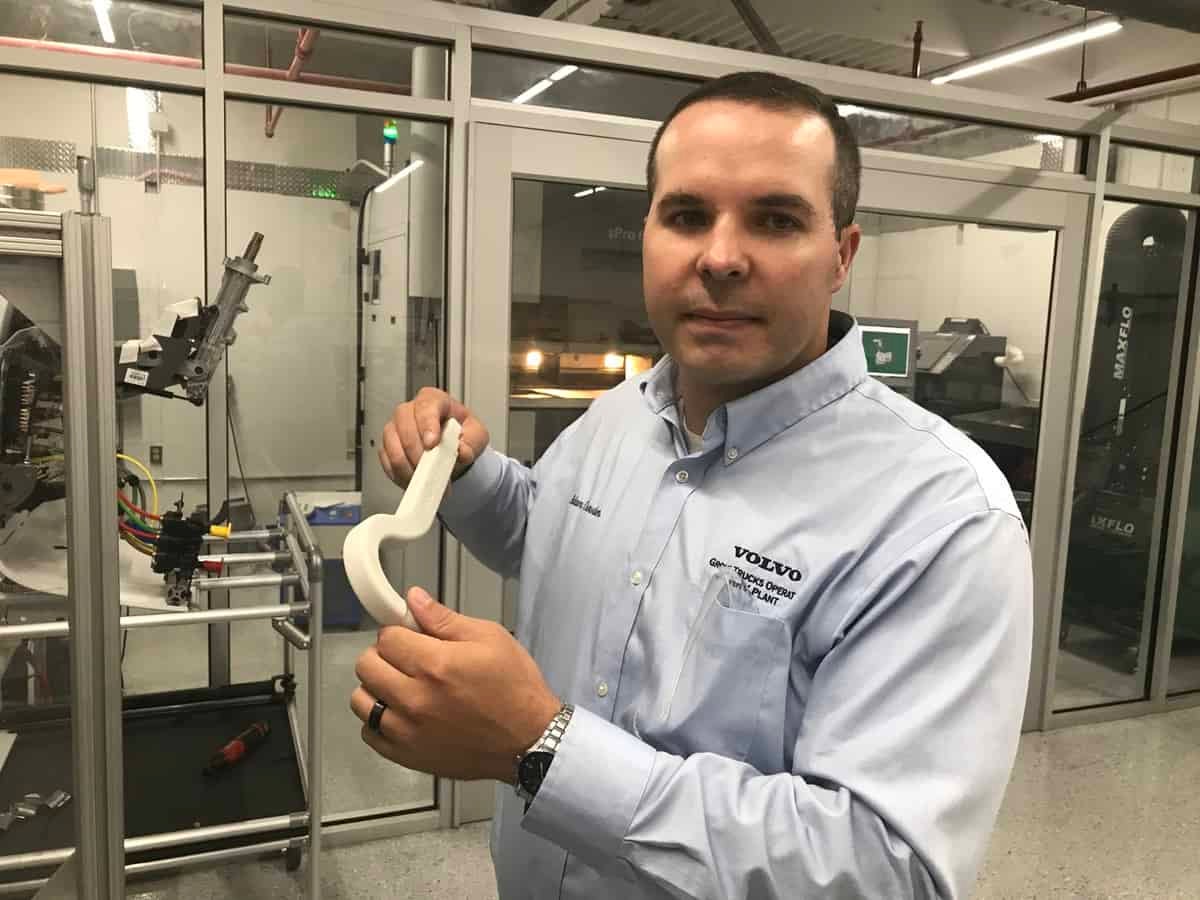Additive manufacturing, also known as 3-D printing, is no longer a fad in truck manufacturing.
Layering tiny particles of plastic, metal and composites to make objects from three-dimensional math data “is a tool in the toolbox,” said Eric Starks, chief executive of FTR Transportation Intelligence. “It is a standard part of the process.”

Plant worker pitches
Volvo Trucks North America counts more than 500 examples of 3D printing of manufacturing tools and fixtures on the plant floor.
“When we started five or six years ago, we did have a lot of non-believers,” said Adam Crowder, manager of advanced manufacturing technologies at Volvo’s New River Valley plant in Dublin, Virginia.
“It took time to start making parts, let people start using parts [and] let them see that maybe this is beneficial in what I do,” Crowder told FreightWaves.
Now ideas regularly come from line workers who visit Crowder’s team in a 1,000-square-foot air-conditioned lab inside the plant. Crowder also evangelizes 3D printing at a dozen Volvo Trucks plants globally,
In the New River Valley plant, a digitally manufactured robot arm grabs and opens truck doors in the paint shop. A one-piece diffuser used to clean paint atomizers saves the company more than $1,000 on each diffuser, in part because multiple pieces were eliminated.
“You can build really complex parts where you’re taking five parts or 15 parts and consolidating them into one,” said Terry Wohlers, an additive manufacturing expert and president of Wohlers & Associates. “That dramatically changes the economics.”
Crowder is particularly proud of a right angle torque tool that emerged from computer-aided design (CAD) software and selective laser sintering in just four hours compared to six weeks needed for traditional manufacturing.
NextGenAM partnership
In April, Daimler AG, the corporate parent of Daimler Trucks completed a two-year pilot program to produce replacement parts and production components. No manual work is required at any stage of the process, from data preparation and central powder supply to the build process and separation of the components from the build platform.
Daimler estimates the cost of manufacturing parts could be reduced by up to 50 percent through its automated production process and continuous data string managed from a control station in Varel, Lower Saxony, Germany. The integrated process chain is scalable and covers all steps from data preparation to quality assurance.
Called NextGenAM, the pilot project started in May 2017. The goal was to create a digitalized manufacturing line capable of producing aluminum components for the automotive and aerospace sectors.
“The pilot plant represents nothing less than a milestone along the way to digital manufacturing,” said Adrian Keppler, CEO of EOS, a systems supplier for industrial 3D printing systems that worked with Daimler and commercial and military aircraft structures-maker Premium AEROTEC.
Daimler Trucks uses a digitally created bracket for a diesel engine, the first replacement truck part manufactured at Premium AEROTEC.

At Daimler Trucks North America in Portland, Oregon, multiple 3D printers are used by Manufacturing Engineering and Prototyping. Several 3D printed parts have been made for aftermarket customers including an aerodynamic-enhancing vortex generator, a heating and air conditioning adapter and a mirror spacer.
Other approaches
Peterbilt Motors Co., a subsidiary of Paccar Inc. has used 3D printing in a variety of applications for more than 20 years, said assistant chief engineer Matt Cullum. What started as rapid prototyping has progressed to assembly templates and production fixtures.
“In the near-term, there could be an instance where we use it in series production for select cases,” Cullum said.
Mack Trucks began using 3D printing in 2015. Most of the printing is for jigs, fixtures and tools to help in truck assembly. The technology is also used to ensure prototypes of new components fit properly, said Roy Horton, Mack director of product strategy.
“One of the main benefits of 3D printing is being able to create light- to medium-duty fixtures with complex geometry that cannot be achieved through conventional machining processes,” Horton said. “Being able to rapidly produce the parts after design is another key benefit.”
Navistar International (NYSE: NAV) is experimenting with 3D printing and cold spray, also known as supersonic particle deposition. It is a high-energy solid-state coating and powder consolidation process.
“3D printing is being investigated for the production of a number of low volume, high-tooling investment, critical service parts,” said Carl Fletcher, Navistar leader of remanufacturing development. “Cold spray deposition is being trialed in the remanufacture of major engine components like crankcases and cylinder heads.”
Still expensive
3D printing still costs more than traditional parts making, Starks said, “so it’s not a snap decision.”
Volvo’s Crowder sees a day when 3D printing could be performed alongside an assembly line.
“The technology is growing faster than people can keep up with it,” Crowder said. “Early on, it was just a fad, but I think it is here to stay. We now have a factory of 3,500 people saying ‘Could we 3D print it?’”











